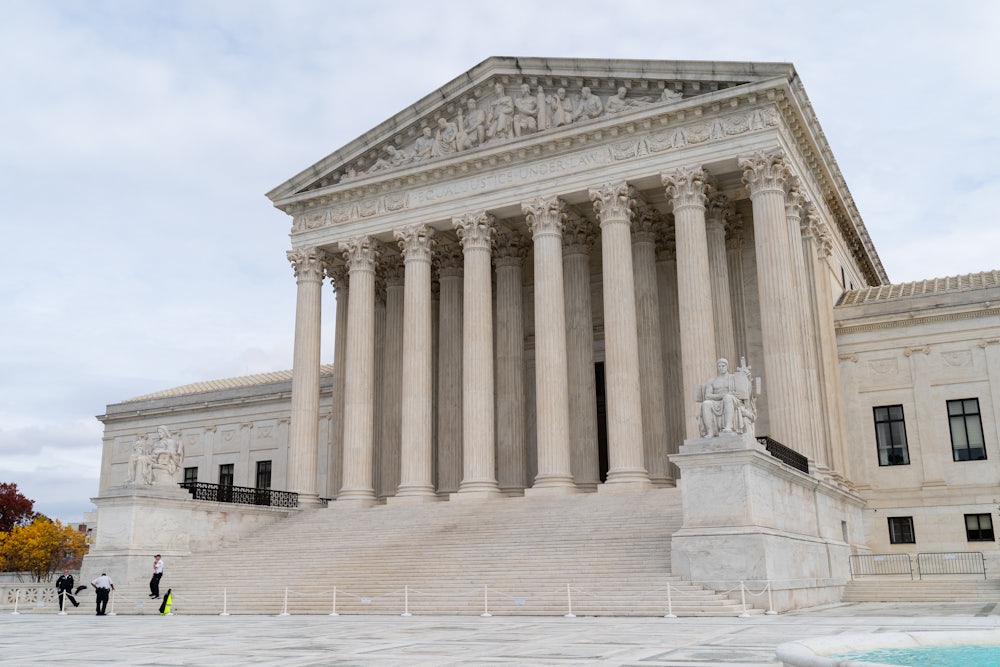Democratic politicians, along with independents and
Republicans who likewise revere democracy, are justifiably savoring 2022
midterm voters’ historic affirmation of the core principle of government by
representatives elected by popular majorities. But these pro-democracy leaders must now pivot to confront an as yet unacknowledged
elephant (pun intended) in the room—the activist reactionary 6-3 supermajority
controlling the Supreme Court.
In a case scheduled for argument on December 7, Moore v. Harper, North Carolina Republican state lawmakers are asking the court to give state legislatures an exclusive monopoly to write every jot and tittle of laws governing elections for federal congresspersons, senators, and presidential electors. The doctrine on which they rely, known as independent state legislature theory, or ISLT, would, in the extreme form they advance, shield state lawmakers from review or check by any other state institution—that is, from governors’ veto power, or from state courts’ authority to enforce state constitutional election requirements. Granting this claim would nullify democratic guarantees embedded in virtually all state constitutions since the founding era, and never questioned until the past few years. Still, at least four of the justices have on recent occasions indicated willingness to consider doing just that.
The court has already reached out aggressively to scale back long-standing democratic election safeguards, most recently in a decision that could well have cost Democrats control of the House of Representatives. As I have written, on February 7, the court, by a 5-4 vote, bypassed regular order to suspend implementation of a unanimous ruling by a panel of three lower court judges—two Trump appointees and one Obama appointee. The panel had held that the 1965 Voting Rights Act required invalidation of the Alabama legislature’s 2022 congressional election district map; that map yielded one Black representative and six white representatives, although Black people constitute 27 percent of the state’s voters. The extraordinary intervention, in an unsigned order with literally no explanation—by Justices Clarence Thomas, Samuel Alito, Neal Gorsuch, Brett Kavanaugh, and Amy Coney Barrett—infuriated, not only the three liberal justices—Stephen Breyer, Sonia Sotomayor, and Elena Kagan—but conservative Chief Justice John Roberts.
Roberts scolded his customary allies: “The district court properly applied existing law in an extensive opinion with no apparent errors for our correction.” In effect, the court suspended a core requirement of the Voting Rights Act outlawing racially discriminatory gerrymandering. Following that lead, federal appellate judges let stand patently racist gerrymanders in several red states—decisions that resulted in Democrats losing between seven to 10 seats, as calculated by Slate’s Mark Stern. Had Democrats won those seats, that likely would have been enough to keep the House blue this year. Whether the final count shows that the court’s norm-shattering February 7 intervention actually flipped the House or merely bloated Republicans’ victory margin, there is no mistaking that five Republican-appointed justices used their raw power to ensure that patently illegal, racially discriminatory redistricting maps stayed in place long enough to govern the 2022 elections. Presumably, they will be prepared to use that power for similarly decisive partisan ends again and again.
Still, Democratic political leaders have stood largely silent in the face of these facts. At a House Judiciary Subcommittee hearing on July 28, witnesses pinpointed the dangers of the North Carolina Republicans’ claim and elaborated its unlawfulness. Unsurprisingly, that hearing received no attention from mainstream media. Likewise, liberal politicians failed to step up and generate the sort of sustained high decibel ruckus that has turned other potentially transformational Supreme Court cases into politically resonant blockbusters. Outside of the legal cognoscenti, this matter has gained little traction: The media and the public remain unaware of this threat, as well as its imminence and gravity.
The muteness of Democratic leaders reflects their long-standing allergy to acknowledging the Supreme Court as a political adversary, and the critical need to make a major political issue of the court’s increasingly errant interpretations of the Constitution and important federal laws. This time, however, they no longer have the excuse that their constituents don’t care and won’t listen.
For decades, most Democratic voters gave low or no priority to the courts or legal disputes, and were unresponsive to Democratic leaders’ sporadic attempts to spotlight the legal right’s accelerating threat to core interests of ordinary Americans. But on November 8, Democratic voters—along with most independent voters, and significant numbers of Republicans or former Republicans—made resoundingly clear that they are now paying very close attention, and they really don’t like what they see. According to the Associated Press VoteCast survey of midterm voters, 38 percent of all voters said that the Supreme Court’s Dobbs decision had a major impact on their decision about whether to vote, and 47 percent said the decision had a major impact on who they voted for, including 64 percent of those who chose Democratic House candidates.
Even more remarkable, voters showed that they cared a lot about another value: preserving democracy—a concern triggered by Trumpist allies’ campaigns to sabotage democratic election laws and administration. Moreover, voters took the trouble to figure out what they needed to do to squelch that threat. In all six of the 2020 battleground states in which election deniers were running to win ordinarily obscure positions responsible for election administration, their Democratic opponents prevailed in all but, possibly, one contest, and frequently by larger margins than Democratic candidates for higher-profile jobs. As New York Times pollster Nate Cohn noted, concern about “democracy [was] concentrated in battleground states in which Stop the Steal candidates would have had the power to subvert national elections.”
With regard to the new threat to democracy pending on the Supreme Court’s docket, these midterm election results yield two huge takeaways. First, Americans of many political stripes have sat up and taken notice of the fact that this Supreme Court majority is capable of drastic changes in the law that would take away fundamental legal protections long taken for granted. Last week, the breadth and intensity of that focus was demonstrated by the November 17 62-37 Senate vote, with 12 Republican yeas, to advance a federal statutory right to same-sex and interracial marriage. Apparently, many people are both aware of, and incensed by, the explicit threats to constitutional protection for rights beyond abortion, spelled out in Justice Alito’s and Justice Thomas’s Dobbs opinions.
The second big takeaway from the midterm results is that popular majorities are alert to threats to undermine democratic (small “d”) elections, and they prioritize rejecting such threats—the very danger posed by ISLT at issue in the pending Supreme Court case. Hence, if alerted, the forces who turned out to vote down political anti-democratic saboteurs would be primed to register outrage at this threat from a different source, namely, the court—outrage on a scale sufficient to signal massive backlash if the justices were to accept Republican legislators’ invitation to strip long-standing democratic safeguards.
But it’s up to Democratic leaders to sound the alarm. As Cohn put it, “No matter how you cut it, you need to elevate these concerns in front of voters. What’s relevant to me is that they responded to those concerns.”
Any such backlash prospect would likely spark attention from at least two of the justices on the right—Chief Justice Roberts and Justice Kavanaugh. Plausibly, that possibility could also concern Justice Barrett, who has sometimes shown discomfort with hard-edged reactionary positions struck by certain right-wing colleagues. Apprehension on the court about potential popular and political repercussions would seem well-based, given the blowback to Dobbs evident in voters’ affirmation of abortion rights and the Senate’s embrace of marriage equality.
Those same manifestations should lead liberal and other pro-democracy leaders to seize this moment of heightened public awareness and mobilize a sustained campaign to target this case—in the process, building capacity to quash other right-wing attempts to use the courts to sabotage democracy.
Potent message points to guide such a campaign are readily at hand. First, the voters just reasserted the constitutional imperative that “We the People” select our representatives, not the other way around. Six unelected, life-tenured justices, who have proven their views on fundamental issues to be well south of mainstream America, have no business attempting to snatch that hallmark of democracy away.
Second, the legal hollowness of the North Carolina legislators’ power grab claim is evidenced by the remarkably bipartisan expert opposition to that claim. In the case, at least eight amicus curiae briefs were filed by or on behalf of prominent conservative and Republican constitutional lawyers, including senior legal officials in the Reagan and both Bush administrations. These include:
- Former Fourth Circuit Court of Appeals Judge J. Michael Luttig, once considered one of President George W. Bush’s most conservative appointees, and author of a recent article entitled, “There is Absolutely Nothing to Support the ‘Independent State Legislature’ Theory”;
- Steven Calabresi, a co-founder of the Federalist Society and prolific constitutional scholar;
- Benjamin Ginsberg, probably the most prominent election litigator for Republican clients before his 2020 retirement, having served as counsel to all three Republican national party committees, and representing four of the past six Republican presidential nominees, including, through his former law firm, President Trump’s 2020 campaign, as well as counsel to the American Governors Association;
- Thomas Griffith, a former George W. Bush appointee to the D.C. Circuit, currently on the Harvard Law faculty;
- Charles Fried, President Reagan’s solicitor general and longtime Harvard Law professor;
- John Danforth, former Republican U.S. senator and state attorney general from Missouri; chief Senate sponsor of Justice Thomas’s nomination to the Supreme Court;
- Carter Phillips, deputy solicitor general under President Reagan, who has since argued more cases before the Supreme Court in private practice than anyone in history.
Further underscoring the breadth and depth of opposition to the ISL claimants, the Conference of Chief Justices, which comprises the top judicial officials in all 50 states, filed an amicus curiae brief arguing that the Constitution does not “oust state courts from their traditional role in reviewing laws under state constitutions.” Explaining to The New York Times why the conference made the “highly unusual” decision to file a brief in a “politically charged” case, the chief justice of Texas’s (yes, Texas!) Supreme Court said, “It’s the biggest federalism [i.e., federal displacement of state authority] issue in a long time. Maybe ever.”
A third message point, which should resonate with most members of the court’s right-wing, is that “originalism,” the interpretative methodology long professed by conservatives, manifestly supports the state chief justices’ constitutional understanding. Originalist scholarship confirms that, when the 1789 Framers wrote that the state “legislature” should “prescribe” the “Time, Place, and Manner of elections” of federal elected officials, they did not mean to repeal state courts’ traditional authority to ensure that all state laws, including election laws, pass muster under their state’s constitution.
As held by the leading Supreme Court case decided over a century ago in 1916, the Framers understood that sentence to refer to the state’s “legislative power,” which would include “the state constitution and laws.” One scholar recently documented that, in the decade after ratification of the original Constitution, all but one state adopted “state constitutional provisions regulating federal elections,” which “would make no sense if the Founding era understood the federal Constitution to bar [such constraints on the legislature’s power].”
And since the founding era, precedent and practice have consistently followed that common sense understanding. As recently as 2019, Chief Justice Roberts elaborated, in approving detail, how state courts have applied their state constitutions to check partisan gerrymandering in congressional elections. Three years later, embracing the North Carolina legislators’ ISLT claim would be hard, indeed, to square with that pronouncement, written in an opinion for the court.
A fourth message point is similarly accessible to media and public audiences, and likely to resonate with some of the right-wing justices: Removing state level checks on legislatures’ rule-setting for electing federal officials would have vast, calamitous, and readily demonstrable real-world consequences. As University of California, Los Angeles, election law expert Richard Hasen has pointed out, Supreme Court embrace of the North Carolina Republican legislators’ theory—which echoes suggestions in recent opinions by Justices Alito, Gorsuch, and Thomas—would “open the floodgates to new litigation in federal courts” because “each routine state judicial or administrative act of gap-filling or interpretation would become the basis for a federal constitutional lawsuit based upon some alleged discrepancy between the statutory text and the interpretation and implementation of that text.” The litigation explosion would especially overwhelm the Supreme Court, Hasen noted, “as it will be asked to consider an ever-increasing number of time-sensitive, election-related motions on its emergency docket.”
As the Brennan Center for Justice has elaborated, such a decision would empower state legislators to ignore, for example, the provisions in all state constitutions but one that guarantee the right to vote in free, fair, equal, or open elections; or the 16-state constitutional guarantees of access to absentee or mail-in voting; or the 14-state constitutional provisions establishing standards or procedures for drawing congressional districts. In that vein, state legislators could ignore state constitutional election safeguards adopted by referendum, such as the ranked choice reform that Alaska adopted in 2020, or Michigan’s 2018 adoption of no-excuse absentee voting, also by referendum.
Last but not least, embracing the North Carolina Republicans’ claim would be a transparently partisan exercise in twisting the law to flip elections. As such, it will be of a piece with recent, increasingly audacious decisions erasing established democracy protections, and tilting the electoral playing field to the right. There is no other way realistically to explain actions like the February 7 shadow docket edict noted above, which shielded several red state’s racially driven gerrymanders from unambiguous Voting Rights Act prohibitions. As Justice Elena Kagan wrote, dissenting from a 2021 decision gutting another unambiguous Voting Rights Act provision, “At odds with Section Two [of the VRA] itself ... to sap the Act’s strength ... mostly inhabit[ing] a law-free zone.” Justice Kagan’s zingers could readily fit, and sharpen, all sorts of politicians’ communications to the media, constituents, or colleagues.
The hour is growing late. Public information campaigns to shape the environment in which future decisions will be made should start early—as soon as prospects for legal challenges from the right surface, or as soon as liberal advocates frame their pitch—not wait until a matter has reached the Supreme Court, or worse, until the court has delivered an adverse result.
But now liberal and other pro-democracy leaders have no choice. They must seize the opportunity revealed by the newly heightened public awareness of Supreme Court radicals’ capacity to pulverize previously unquestioned legal guarantees. They must drive home the fact that Dobbs was not a one-off aberration, but just one of many items in a broad and transformational, reactionary agenda. And they must reiterate, over and over, that the Supreme Court’s right wing, no less than election-denying politicians, is a threat to subvert the Constitution’s guarantee of a truly democratic republic. This means building robust, sophisticated campaigns that can center those—perfectly valid—memes in media and public consciousness, keep them there, and generate a viable launchpad for potential remedial action. For Democrats, to continue finessing this challenge could amount to political suicide.






